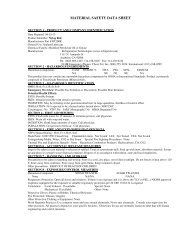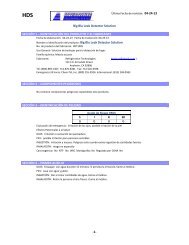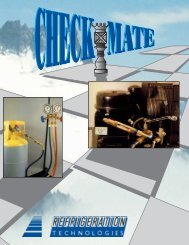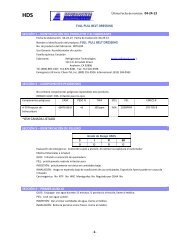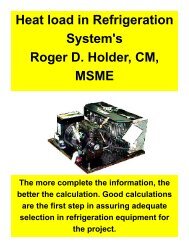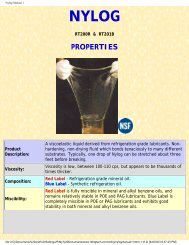Balancing of a Water and Air System (PDF
Balancing of a Water and Air System (PDF
Balancing of a Water and Air System (PDF
Create successful ePaper yourself
Turn your PDF publications into a flip-book with our unique Google optimized e-Paper software.
28<br />
static pressure supplied by the unit manufacturer.<br />
3. Normally, about three complete passes around the entire system are required for<br />
proper adjustment. Make a final pass without adjustments to record the end result.<br />
4. To provide the quietest possible operation, adjust the fan to run at the slowest speed<br />
that provides sufficient nozzle pressure to all units with minimum throttling <strong>of</strong> all unit <strong>and</strong><br />
riser dampers.<br />
5. After balancing each induction system with minimum outside air, reposition to allow<br />
maximum outside air <strong>and</strong> check power <strong>and</strong> static pressure readings.<br />
Duct <strong>System</strong> Pressure<br />
The duct system designer calculates the static pressure losses <strong>of</strong> the straight section <strong>of</strong><br />
ductwork using engineering tables <strong>and</strong> charts. To these losses, the losses <strong>of</strong> the entire<br />
duct fitting are calculated <strong>and</strong> added along with the pressure loss data <strong>of</strong> all<br />
manufactured items such as filters, coils, dampers <strong>and</strong> diffusers or grills. The duct<br />
system fan(s) are selected from the total static pressure losses <strong>of</strong> the longest run(s) <strong>of</strong><br />
the supply air <strong>and</strong> return air ducts connected to the fan(s).<br />
The three duct pressure that technicians measure in the field are total pressure (TP),<br />
static pressure (SP), <strong>and</strong> velocity pressure (Vp). The three pressures are related by the<br />
following equation:<br />
Total pressure in w.g. (TP) = Static pressure in w.g. (SP) + Velocity pressure in w.g. (Vp)<br />
Static pressure<br />
Static pressure (SP) is exerted equally in all directions at any point or cross section <strong>of</strong><br />
the duct. It also is a measure <strong>of</strong> the potential energy to produce <strong>and</strong> maintain airflow<br />
against duct resistance. Static pressure may be positive or negative to the atmosphere,<br />
but it can be measured indirectly by subtracting the velocity pressure from the total<br />
pressure (SP = TP – Vp).<br />
Velocity pressure<br />
Velocity pressure (Vp) is exerted only in the direction <strong>of</strong> airflow <strong>and</strong> is a measure <strong>of</strong><br />
kinetic energy resulting from the airflow. Velocity pressure cannot be measured directly<br />
by a pitot tube <strong>and</strong> pressure gauge or manometer, but it can be measured indirectly by<br />
subtracting the static pressure from the total pressure (Vp = TP – SP).<br />
Vp = (Velocity in fpm / 4005)²<br />
Total pressure<br />
Total pressure (TP) <strong>of</strong> a duct is measured by the impact <strong>of</strong> the moving air stream on the<br />
end <strong>of</strong> a Pitot tube directly facing <strong>and</strong> perpendicular to the airflow. Total pressure<br />
28




